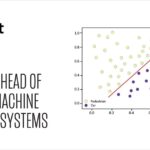Reframe Systems is using off-the-shelf robotic arms to frame walls. | Source: Reframe Systems
The U.S. is currently facing a deficit of 4.7 million homes, according to the U.S. Chamber of Commerce. On top of that, many existing homes are not resilient enough to rapidly changing weather patterns brought on by climate change. Andover, Mass.-based Reframe Systems is working to tackle this problem with robotic microfactories.
Vikas Enti, CEO of Reframe Systems, founded the company in 2022 with Aaron Small, now the head of operations. Enti is a mechanical engineer by training. However, he spent most of his background in mobile robotics working for Kiva and then Amazon, Enti told The Robot Report.
At Amazon, Enti helped deploy over half a million robots, helping to make same-day shipping a reality for many people. After he became a father, Enti switched gears to focus on working to help alleviate carbon emissions. After a year of investigating the problem, he decided the housing industry was the right avenue for driving change.
Now, over three years since it was founded, Reframe Systems is working to build homes after the Los Angeles fires. In August, it raised $20 million in funding to keep scaling its microfactories. Currently, the company plans to build 1 million homes by 2045.
Reframe Systems tackles fragmented construction industry

During his time at Amazon, Enti deployed more than 500,000 robots across over 70 installations. | Source: Reframe Systems
Construction is a particularly challenging industry to automate because of its fragmented nature, explained Enti.
“The construction industry is as fragmented as an industry as it can get,” he said. “To build a home, you need about 25 different subcontractors to show up, because everyone’s specialized. This has resulted in a world where every company is effectively a small business, so they don’t have the resources to invest in R&D or to take on a larger play to adopt new technology.”
“[Robotics] really hasn’t gained as much traction just because the companies are all operating as small businesses, not being able to think long term,” added Enti. “The other challenge with the industry has been, even though the process is highly fragmented, there isn’t a product-based mindset, because there isn’t a product. It gets really challenging.”
To tackle these challenges, Enti said his team is focused on changing processes in construction. Automating a bad process is one of the worst things you can do, he noted. That’s why Reframe decided to take the microfactory approach. It helps to eliminate that fragmentation so the startup doesn’t need to bring robots to the job site.
Microfactories could build houses more efficiently

With its microfactories, Reframe can frame and assemble homes away from the worksite. | Source: Reframe Systems
With the microfactories, Reframe Systems can build a home in the most efficient way possible, without regard to assembling it from the ground up as at a typical job site. The company’s goal is to automate 60% to 80% of construction on these homes, said Enti.
“We actually both get to bend gravity and also drive a better process, where we get to consolidate all operations,” he explained. “What I mean here is, I actually get to build ceilings and walls before I build the floor. That’s not possible on the job site.”
When it comes to automation, Reframe Systems is starting with using robots to prepare and install wall panels.
“We use standard, industrial, off-the-shelf arms,” Enti said. “All of our IP is in our vision system, motion planning system, and the end-of-arm tool. We have some IP around how we use magnets for fixturing.”
“We’re one of the only systems out there today where we’ve added this direct link from our CAD platform to the robot,” he continued. “That’s been super powerful in unlocking different types of framing assemblies and geometries that allow us to shine.”
Reframe is taking automation one step at a time. Its goal is to keep building new tools once it gets one part of the process automated.
“The goal is to keep building new tools where we can then do insulation, install the windows, install wiring, plumbing assemblies, and sort of do all of our work with the panel as the building block,” Enti said.
Further down the line, the company is looking into automating gantry cranes to help turn the panels into volumetric modules, but Enti said this could be three or four years away.
Reframe Systems integrates AI into its business
Enti outlined the many ways in which Reframe Systems is using artificial intelligence to make the home-building process more efficient. It’s using AI to better understand visual data and to help its robots eventually take on more complex tasks, like installing wiring or a pipe.
“We believe we have the dexterity available on the end-of-arm tools and the hardware side, we just don’t have the software dexterity,” Enti acknowledged. “I think this is a place where we see a lot more scope for transformer models, which were actually trained on synthetic data, to drive a lot more exercises, and get to the world a lot faster.”
However, it isn’t just applying AI to its robots. “So for us to get really good at the home building process, it isn’t just enough to automate the construction or the manufacturing piece. We’ve actually had to do a lot of work upstream on how do you actually make the design process more efficient,” Enti said.
The design process, reflecting much of the construction industry, is very fragmented. Home building requires mass customization, something robots aren’t necessarily great at. To address this, Reframe Systems is applying algorithms to automate sections of the design process. The algorithm might move the placement of a window or the location of a substructure, Enti said.
“The place where we’re starting to use transformers has been on, once we regenerate these patterns, how do we make sure we’re actually compliant from a building code standpoint and from a zoning standpoint?” Enti said. “This is a place where LLMs [large language models] have actually lent themselves really well in being able to parse building code data and local zoning data.”
The ultimate goal is to create a building that can essentially design itself, he said. “I think we can actually get to a world where the software is going through hundreds of iterations to present the most optimal situation and not have any guesswork, and actually have it be rooted in the latest data, latest analysis, and trends,” Enti said.
Tackling labor shortages in construction

Reframe isn’t just building more homes; it’s also building houses to be more resilient against climate change. | Source: Reframe Systems
Enti emphasized that robotics will be doing the repetitive, laborious work that comes with building homes. “We’re not a robotics company looking to sell robots,” he said. “We’re trying to solve for labor productivity, and we see robots as a viable tool there.”
Already, the construction industry is facing a labor shortage. In the next 10 years, however, 40% of the trade force is set to retire. This makes the labor issue even more pressing.
Reframe Systems is working to find ways to introduce people into its workforce and augment the work robots are doing. The company is working with students from a local trade school, who are learning to operate a robotic workcell and do basic carpentry and wiring.
“The tasks that we’re so focused on automating are also not the enjoyable tasks for our builders,” said Enti. “We actually have a pretty robust team of expert builders, and they’ve been pretty happy with the robot taking the dull, repetitive tasks.”
He added that robots aren’t great at finished carpentry and other highly skilled aspects of trades, so the people working in them can focus more time on that and less time on tasks they don’t enjoy.
“I’d rather have a company with people and robots working side by side versus just robots,” Enti said. “And we feel very strongly about this as a team, I think that’s the future we want to create.”




























